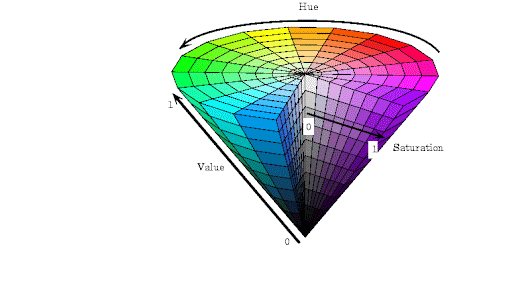Physical Address
304 North Cardinal St.
Dorchester Center, MA 02124
Physical Address
304 North Cardinal St.
Dorchester Center, MA 02124
→ GUI for detecting objects using color information with OpenCV and Tkinter.
When you see the title, you might be surprised or think that I am some kind of fraud. I am not a fraud, because it will be a simple detector, not like popular object detection models such as YOLO, SSD, and Faster R-CNN. These deep learning models are powerful, and they can detect different kinds of objects under complex scenes, but they require a lot of data, computational power, and time.
By using classical computer vision approaches, we will create a simple object detector. Detection will be made by following the color pattern of an object. It will be a simple detector, and it will work under basic environments like the sky, where the background is clear and doesn’t contain different colors.
There are different color spaces that you can use in OpenCV. The most popular ones are:
In this article, we will focus on HSV color space

HSV stands for Hue, Saturation, and Value. It is a color space representation that is often used in image processing and computer vision tasks.
The advantages of using the HSV color space for color selection are that it allows for easy manipulation of hue, saturation, and value. However, a disadvantage is that it may not accurately represent all colors.(source)
If you look at this image carefully, you will notice that you cannot obtain all the colors.

findContours function.
Okay, now it is time for coding. I explained most of the code with comment lines. Actually, this code represents the four steps mentioned above, plus some code for creating a simple graphical user interface with Tkinter.
import cv2
import numpy as np
import tkinter as tk
from tkinter import ttk
from PIL import Image, ImageTk
class ColorPickerApp:
def __init__(self, master):
self.master = master
self.master.title("Color Picker")
self.master.geometry("800x600") # Adjust the size of the window
# Create a frame to hold the color bar and color image
self.color_bar_frame = tk.Frame(master)
self.color_bar_frame.pack(side="top", fill="x", padx=5, pady=5)
self.hue_label = ttk.Label(self.color_bar_frame, text="Select Hue Value (10-179):")
self.hue_label.pack(side="left", padx=5, pady=5)
self.hue_scale = ttk.Scale(self.color_bar_frame, from_=10, to=179, orient="horizontal", command=self.update_color)
self.hue_scale.pack(side="left", padx=5, pady=5)
# Create a canvas for the color image
self.canvas_color = tk.Canvas(master, width=100, height=320)
self.canvas_color.pack(side="left", padx=5, pady=75)
# Create a canvas for the image
self.canvas_image = tk.Canvas(master, width=800, height=400)
self.canvas_image.pack(side="top", padx=5, pady=50)
self.detect_button = ttk.Button(master, text="Detect Objects", command=self.detect_objects)
self.detect_button.pack(side="top", padx=5, pady=5)
self.image = None
self.image_rgb = None
self.image_hsv = None
# Video capture
self.cap = cv2.VideoCapture("fish.mp4") # Change to 0 for webcam, or provide path for video file
# Load the initial frame
self.load_frame()
def load_frame(self):
ret, frame = self.cap.read()
if ret:
self.image = frame
self.image_rgb = cv2.cvtColor(frame, cv2.COLOR_BGR2RGB)
self.image_hsv = cv2.cvtColor(frame, cv2.COLOR_BGR2HSV)
# Display the frame with detected regions
self.display_frame(self.image_rgb)
self.master.after(100, self.load_frame) # Continue to load frames
def update_color(self, value):
hue_value = int(float(value))
color_image = np.zeros((400, 100, 3), dtype=np.uint8)
color_image[:, :] = (hue_value, 255, 255)
color_image_rgb = cv2.cvtColor(color_image, cv2.COLOR_HSV2RGB)
color_image_rgb = Image.fromarray(color_image_rgb)
# Display the color image
color_image_tk = ImageTk.PhotoImage(image=color_image_rgb)
self.canvas_color.create_image(0, 0, anchor="nw", image=color_image_tk)
self.canvas_color.image = color_image_tk
def display_frame(self, frame):
img = Image.fromarray(frame)
# Get the original frame dimensions
frame_width, frame_height = img.size
# Define maximum width and height
max_width = 600
max_height = 300
# Calculate target width and height
target_width = min(frame_width, max_width)
target_height = min(frame_height, max_height)
# Calculate aspect ratio
aspect_ratio = frame_width / frame_height
# Adjust dimensions if necessary to fit within limits
if aspect_ratio > max_width / max_height:
target_width = max_width
target_height = int(target_width / aspect_ratio)
else:
target_height = max_height
target_width = int(target_height * aspect_ratio)
# Resize the frame while maintaining the aspect ratio
img = img.resize((target_width, target_height), Image.LANCZOS)
# Convert the resized frame to PhotoImage
img = ImageTk.PhotoImage(image=img)
# Clear previous frame and display the resized frame
self.canvas_image.delete("all")
self.canvas_image.create_image(0, 0, anchor="nw", image=img)
self.canvas_image.image = img
def detect_objects(self):
if self.image is None:
return
print("detecting objects")
# Define the hue range based on the current value of the hue scale
hue_value = int(self.hue_scale.get())
lower_limit = np.array([hue_value - 8, 100, 100])
upper_limit = np.array([hue_value + 8, 255, 255])
# Create a mask to detect objects within the specified hue range
mask = cv2.inRange(self.image_hsv, lower_limit, upper_limit)
contours, _ = cv2.findContours(mask, cv2.RETR_EXTERNAL, cv2.CHAIN_APPROX_SIMPLE)
# Draw rectangles around the detected objects
for contour in contours:
print("contour found")
#if cv2.contourArea(contour) > 50:
x, y, w, h = cv2.boundingRect(contour)
cv2.rectangle(self.image_rgb, (x, y), (x + w, y + h), (255, 255, 0), 5)
# Display the updated frame with detected objects
self.display_frame(self.image_rgb)
# Call detect_objects again after a delay
self.master.after(50, self.detect_objects)
def main():
root = tk.Tk()
app = ColorPickerApp(root)
root.mainloop()
if __name__ == "__main__":
main()